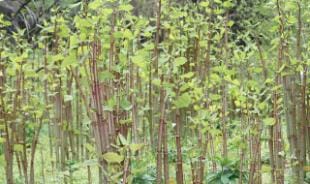As spring burgeons in garden and countryside the non-native invasive plants are romping ahead again. Whilst they may look pretty in the garden, their habits are not. We all need to be on the lookout to keep land well managed and not allow these plants to dominate and cause problems. Here is a handy identity key for the top four invaders to watch out for:
Japanese Knotweed – Fallopia japonica
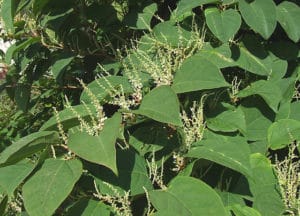
This is a tall herbaceous vigorous perennial with bamboo-like stems that appear in spring. It grows up to 2.5m tall, often forming dense thickets. Characteristic leaves and stems, the persistence of last year’s dead winter knotweed canes, and distinctive rhizome (underground root-like stems) enable year round identification. It can spread very quickly from small fragments of rhizome.
Why is it invasive?
- Spreads easily from root fragments
- High root density
- Ability to survive where others don’t.
- Ability to store huge energy reserves.
Its presence can cause significant delays and cost to building development. It can prevent property sales, re-mortgaging and development until it is eradicated.
Giant Hogweed – Heracleum mantegazzianum
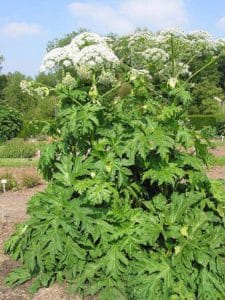
Giant hogweed identification is easier when the plant is fully grown. The plant’s height, the size and shape of the leaves and flowers all provide helpful identifiers. However, it can be confused with native hogweed when not fully grown or when growth is stunted (e.g. regrowth after cutting).
Why is it invasive?
- Exceptional seed production with <20,000 seeds per plant.
- Viable seeds can last 4-5 years in ground
It poses serious health risk on skin contact causing phytophotodermatitis in humans, resulting in blisters and long-lasting scars.
Himalayan Balsam – Impatiens glandulifera
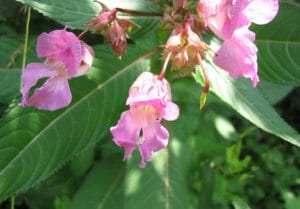
A tall, attractive, annual herb with explosive seed heads. Whilst, identification of Himalayan balsam can be relatively easy when dealing with a mature plant – with its pink-purple flowers, fleshy stems, and characteristic leaves – the seedlings and the previous year’s dead stems are more difficult to spot.
Why is it invasive?
- Easily reproduces by seed.
- Outcompetes native plants.
- Ability to survive where others don’t.
Dieback of extensive stands over winter can result in river bank erosion.
Rhododendron – Rhododendron ponticum
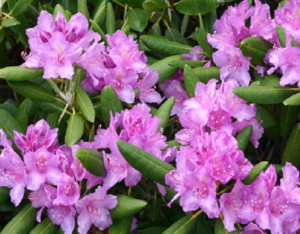
This large woody evergreen shrub with leathery leaves can grow to 8m high. When mature attractive purple to pink flowers produce thousands of tiny wind-scattered seeds. A single plant can cover many meters of ground effectively suffocating all other plant growth. Rhododendrons are often found growing in ecologically sensitive habitats eg. heathland.
Why is it invasive?
- Out-competes native plants by shading them out.
- Reduction in earthworms, birds, and insects.
- Host for unwanted fungal pathogens.
- Plant toxins make leaves unpalatable to animals.
Creates toxic mulch impacting land.
Control Options
The control methods are similar for each species, however specialist advice and implementation is advisable. Control options include:
- Herbicide application.
- Excavation and removal to a landfill site able to take invasive weed material.
- Excavation and burial on site encapsulated in Root Barrier fabric.
- Giant Hogweed can be controlled by cutting back prior to seed-head development.
- Himalayan balsam can be pulled from the ground before they flower.
For further information you may wish to read the Code of Practice for the Management of Japanese Knotweed, produced by the Property Care Association, and which PBA Solutions implement.
The Forestry Commission has produced a Best Practice guide: Managing and controlling invasive rhododendron. If practical assistance is required you can visit our Rhododendron Removal page.
So get out in the sunshine and enjoy the glorious spring. And if you do spot a suspicious plant then get in touch with us for support and remedy by using the link to contact us.


